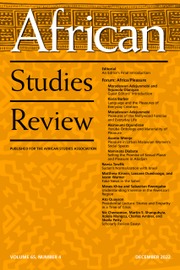Léa Lacan’s Forest Politics in Kenya’s Tugen Hills: Conservation beyond Natural Resources in the Katimok Forest is a groundbreaking exploration of the dynamic relationship between humans and forests in the context of Kenya’s colonial and postcolonial forestry policies. Lacan reframes forests not as static resources but as evolving entities, shaped by the interactions between people, history, and politics. She provocatively asserts, “forests are not, they become; and sometimes, they become with people” (227), laying the foundation for her compelling analysis of Katimok Forest as both a material and symbolic landscape.
Through a blend of environmental history, political ecology, and multispecies studies, Lacan examines how colonial and postindependence policies constructed forests as “categories and territories of nature and state power” (227). These policies marginalized local practices and knowledge, emphasizing state-controlled conservation and resource exploitation. She argues that this approach not only disregarded indigenous conservation practices but also “laid the groundwork for the degradation of the forest resource” under corrupt regimes (228).
The book’s three parts illuminate different aspects of the forest’s history and its significance to the local community. The first part traces the colonial and postcolonial history of forestry in Kenya, highlighting the continuity of policies that prioritized state control and modernization over local needs. Lacan critiques this model as one that excluded local stakeholders, perpetuating the colonial vision of forests as state assets.
The second part focuses on the lived realities of Katimok’s inhabitants. Lacan portrays the forest as integral to subsistence and resilience, noting how practices like logging—often deemed illegal—are deeply rooted in historical dispossession and economic struggle. Rather than framing these activities as mere resistance, she demonstrates that they reflect a complex interplay of politics, ethics, and survival. As she observes, “Despite historical efforts being made towards its establishment, state control over Katimok is relative, and the forest remains in the hands of its local users” (229).
The third part explores the emotional and material ties between people and the forest, presenting Katimok as a “landscape of belonging” (227). Lacan eloquently illustrates how claimants use remnants of past forest lives—such as hearth stones—as tangible evidence of dispossession and political leverage. These “ruins,” she explains, become “material symbols of their ruined forest lives” and a powerful tool for advancing claims (224). Lacan emphasizes that this politicization of belonging is not merely strategic but deeply emotional, rooted in “anger and suffering” over historical injustices.
A major strength of the book lies in its integration of political ecology with a more-than-human perspective. Lacan conceptualizes Katimok as a “human-sylvan assemblage,” shaped by the interdependencies of humans, trees, and other species (236). This framework enriches the analysis of forest politics, showing how the material environment itself acts as an agent in shaping claims and negotiations. “The political agency of the forest is therefore situated in between the landscape that provides a material anchorage for emotions, memories, and proofs, and the claimants who interact with it” (224).
In her conclusion, Lacan calls for a decolonization of forest conservation. She critiques the state-centered approach, advocating for models that recognize and value local knowledge and practices. Drawing on Malcolm Ferdinand’s concept of “decolonial ecology,” she highlights the need for conservation approaches that address historical injustices while fostering coflourishing between humans and nonhumans (234). She also aligns with proponents of “convivial conservation,” which seeks to integrate human and nonhuman well-being through relational and participatory methods (238).
Although the book offers a rich and nuanced perspective, it risks romanticizing local practices and indigenous knowledge. Lacan herself acknowledges this danger, cautioning against using such knowledge as a “catchword” without engaging its depth and diversity. Despite this, her meticulous examination of the Katimok Forest and its inhabitants provides a compelling argument for rethinking conservation as a deeply political and relational process.
Forest Politics in Kenya’s Tugen Hills is a profound contribution to environmental studies, political ecology, and postcolonial scholarship. It challenges readers to reconsider the meaning of forests, conservation, and belonging, urging a shift from resource-centric approaches to those that honor the complexities of human and nonhuman interrelations. Lacan’s assertion that “conservation futures are more-than-human futures” (237) is both an academic revelation and an ethical call to action, inviting us to imagine a world where people and forests thrive together.


